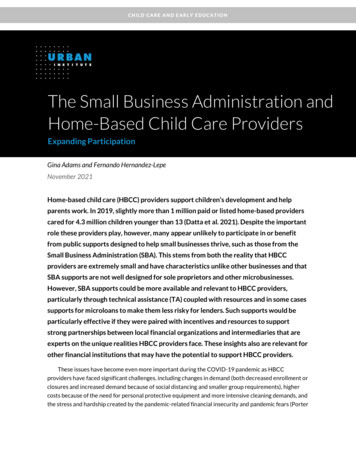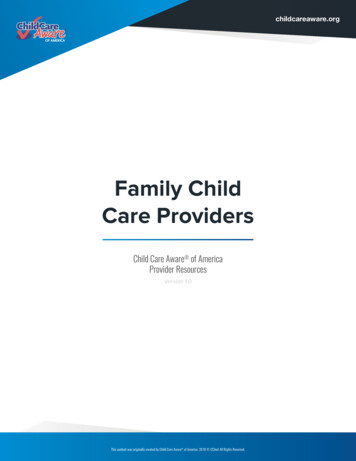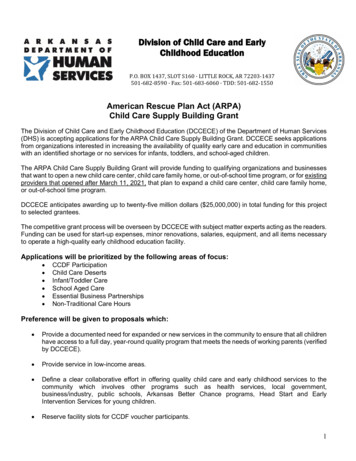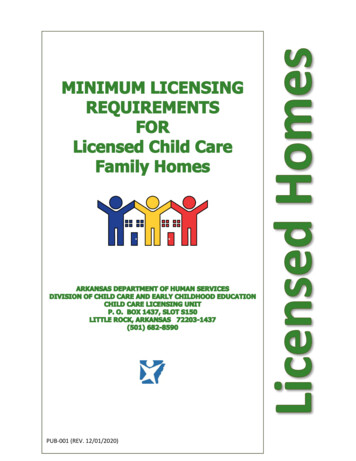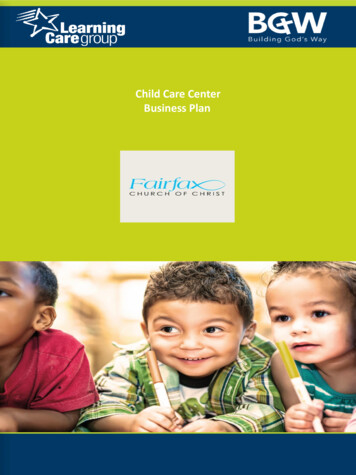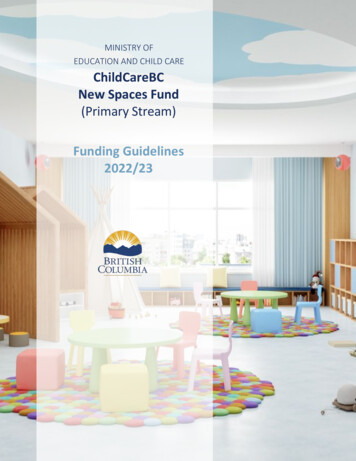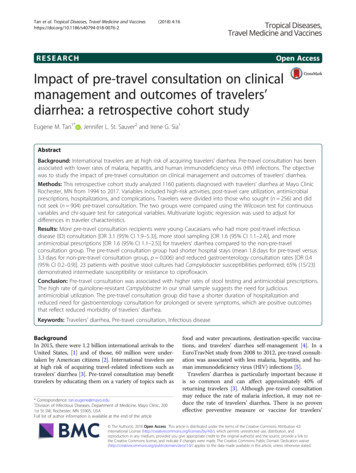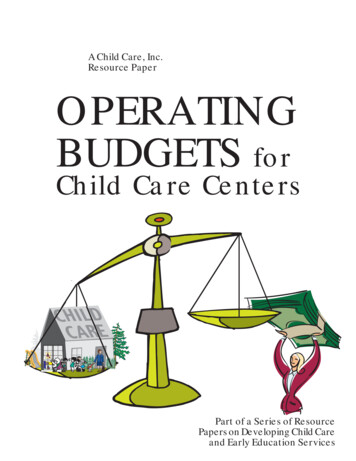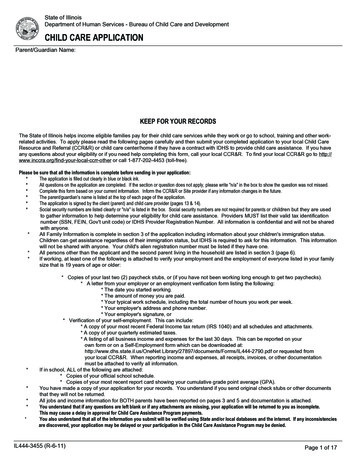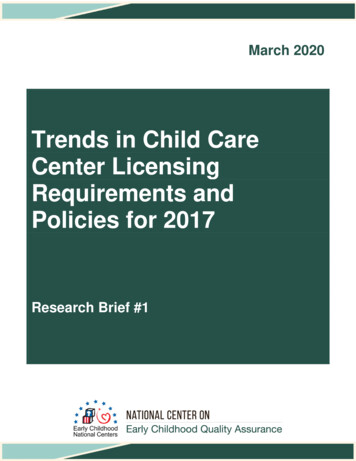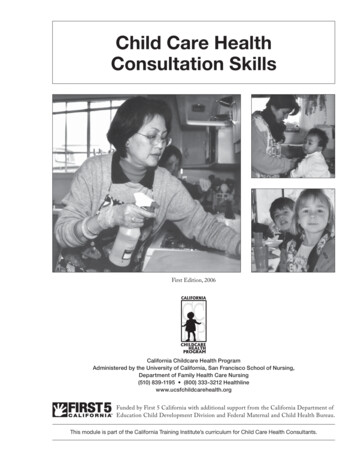
Transcription
Child Care HealthConsultation SkillsFirst Edition, 2006California Childcare Health ProgramAdministered by the University of California, San Francisco School of Nursing,Department of Family Health Care Nursing(510) 839-1195 (800) 333-3212 Healthlinewww.ucsfchildcarehealth.orgFunded by First 5 California with additional support from the California Department ofEducation Child Development Division and Federal Maternal and Child Health Bureau.This module is part of the California Training Institute’s curriculum for Child Care Health Consultants.
AcknowledgementsThe California Childcare Health Program is administered by the University of California,San Francisco School of Nursing, Department of Family Health Care Nursing.We wish to credit the following people for their contributionsof time and expertise to the development and review of this curriculum since 2000.The names are listed in alphabetical order:Main ContributorsAbbey Alkon, RN, PhDJane Bernzweig, PhDLynda Boyer-Chu, RN, MPHJudy Calder, RN, MSLyn Dailey, RN, PHNRobert Frank, MSLauren Heim Goldstein, PhDGail D. Gonzalez, RNSusan Jensen, RN, MSN, PNPJudith Kunitz, MAMardi Lucich, MACheryl Oku, BAPamm Shaw, MS, EdDMarsha Sherman, MA, MFCCEileen Walsh, RN, MPHSharon Douglass Ware, RN, EdDRahman Zamani, MD, MPHAdditional ContributorsRobert Bates, Vella Black-Roberts, Judy Blanding, Terry Holybee, Karen Sokal-GutierrezOutside Reviewers, 2003 EditionJan Gross, RN, BSN, Greenbank, WAJacqueline Quirk, RN, BSN, Chapel Hill, NCAngelique M. White, RNc, MA, MN, CNS, New Orleans, LACCHP StaffEllen Bepp, Robin Calo, Catherine Cao, Sara Evinger, Joanna Farrer, Krishna Gopalan, Maleya Joseph, Cathy Miller,Dara Nelson, Bobbie Rose, Griselda Thomas, Kim To, Mimi WolffGraphic DesignersEdi Berton (2006), Eva Guralnick (2001-2005)We also want to thank the staff and Advisory Committee members of the California Childcare Health Programfor their support and contributions.California Childcare Health ProgramThe mission of the California Childcare Health Program is to improve the quality of child care by initiating andstrengthening linkages between the health, safety and child care communities and the families they serve.Portions of this curriculum were adapted from the training modules of the National Training Institute for Child Care HealthConsultants, North Carolina Department of Maternal and Child Health, The University of North Carolina at Chapel Hill; 2004-2005.Funded by First 5 California with additional support from the California Department of Education Child Development Divisionand Federal Maternal and Child Health Bureau.
LEARNING OBJECTIVESTo identify the partners and resources needed to promote healthy and safe early care andeducation (ECE) programs.To describe the skills a Child Care Health Consultant (CCHC) needs to be an effective consultant,communicator and problem-solver.To describe the roles of individuals involved in the consultation process.To describe why ECE programs need to have clearly defined health and safety policies.To identify the reasons why consultation plans and documentation are required in child care healthconsulting.To identify community and family resources to assist and support ECE providers and families.Building An Infrastructure:Advocacy andProfessional DevelopmentWHY IS BUILDING AN INFRASTRUCTURE IMPORTANT?An integral part of child care health consulting is linking with other key agencies and players in the local community, state and country. Health professionals working in geriatrics naturally strive to improve the lives ofseniors in all aspects of their lives. Oncology clinicians and educators frequently broaden their interests beyondimmediate patient care to policy and legislation in the areas of tobacco and environmental health. This is howCCHCs will build successful CCHC practices as well—by educating themselves about wider early childhoodinitiatives and joining forces with agencies and organizations to improve the lives of children.Through their experiences as nurses and other health professionals, CCHCs are used to advocating for patientsafety, access to care, and other health care issues. They join coalitions to increase their strength and voices, andcontinually strive to stay at the forefront of their field and improve their clinical skills and knowledge. The sameadvocacy, coalition building and professional development strategies used by CCHCs in their previous work willapply to child care health consulting.Child Care Health Consultation SkillsnCalifornia Training InstitutenCalifornia Childcare Health Programn1
WHAT THE CCHCNEEDS TO KNOW parental stress, domestic violence and other childabuse prevention services seamless access to services for children and families and other interagency efforts to streamlineservicesAdvocacyCCHCs can learn about national, statewide and localefforts to improve the quality and availability of ECEprograms. Key areas of advocacy to study include: compensation and training for ECE providers health care reform and insurance coverage forchildren and families inclusion of children with disabilities and otherspecial needs cultural diversity and competence in early childhood and health programs parent involvement in ECE policies and services federal and state budgets as they affect familiesand ECE programs environmental legislation and safeguards mental health services for children and families welfare reform and child care impact child abuse preventionCoalition-BuildingWhile there are likely to be existing coalitions working on the advocacy areas listed above, CCHCs mayalso find they can spearhead or facilitate the creationof new coalitions that focus on health and safety forECE programs in areas such as: perinatal services nutrition issues, including anemia, food security,WIC and Child Care Food Program oral health car seat safety and other injury prevention efforts immunizations and other preventive health careservices2nChild Care Health Consultation SkillsnProfessional DevelopmentCCHCs are already familiar with the resources available in their communities for continuing educationfor nurses and other health professionals, but there areadditional opportunities for professional developmentspecific to child care health consulting. In addition toattending conferences and meetings on health issuessuch as asthma and other chronic health concerns,community violence prevention and indoor air quality, CCHCs can attend professional meetings of thefollowing organizations:Early Childhood Education Conferences andMeetings National Association for the Education ofYoung Children (NAEYC) conferences California Association for the Education ofYoung Children (CAEYC) conferences andthose of their local chapters Program for Infant/Toddler Caregivers - WestEd Resource and Referral Network conferences andevents—National and California Child CareResource and Referral Network Local Child Care Planning Councils’ meetings,conferences and workshops Head Start and Early Head Start Zero to ThreeConferences and Meetings of HealthProfessional Groups and Organizations National Association of Pediatric Nurse Associates and Practitioners (NAPNAP) American Academy of Pediatrics (AAP)Child Care Health Consultation in the Early Care and Education Setting
California School Nurses Organization (CSNO) American Dietetics Association (ADA) Physicians for Social Responsibility American Public Health Association and localaffiliatesConferences and Meetings Sponsored byState Agencies and DepartmentsThe next step is to market the project to stakeholders.Attempt to identify the “angle” for each key player.How would both sides benefit from collaboration?Contact and introduce yourself and your project to awide variety of early childhood and public health professionals. Consider ECE programs (staff, directors,center-based, family ECE providers), communitycollege early childhood education departments, Community Care Licensing staff, clinicians, public healthorganizations, health and safety trainers, and ECEstaff advocates. California Department of Health Services California Children and Families Commission—First 5 CaliforniaDevelop and follow a plan when working collaboratively. Set parameters for a mutually beneficialpartnership. California Department of Education/ChildDevelopment DivisionUse the following ideas to establish an infrastructure: Community College Child Development Training Consortium California Department of Social Services Community Care Licensing Division California Maternal, Child and AdolescentHealth Directors California Coalition for Childhood Immunizations California Childhood Lead Poisoning Prevention Program Branch of Department of HealthServicesWHAT THE CCHCNEEDS TO DO Establish a shared or linked philosophy andmission to provide a solid foundation for thepartnership. Return to the shared mission if partners clash. Identify and assert the benefits of the partnership for children and families, and for eachpartner. Link the partnership to an overall commitmentto and vision of quality. Return to this conceptrepeatedly. Start small. Set realistic expectations for change.Remember that systemic change is a long-termprocess. Create opportunities for success ratherthan disappointment.CommunicateEstablish an InfrastructureCCHCs can begin by identifying the stakeholders intheir communities and beyond to join with in collaboration. Consider who must be involved for the effortto succeed. Next, consider who wants to be involved.And finally, consider those whose involvement wouldgreatly benefit the job.Child Care Health Consultation SkillsCreate and Share a Visionn Create and sustain a spirit of openness, flexibilityand confidence about the partnership. Decide how and when partners will communicate to exchange information, and to addresspartnership issues. Communicate often, andconsider the use of email bulletins to keep everyone up-to-date and involved.Work at It Commit thoroughly to all aspects of partnership:California Training InstitutenCalifornia Childcare Health Programn3
expectations, financial and legal requirementsand standards, systems, resources, etc. Educate all entities/parties about relevant federal, state and local laws and regulations. Build an atmosphere in which you can apply thepartnerships’ “lessons learned” to future worktogether. Remember: successful partnerships createmutual benefits, but they also require mutualcompromise and sacrifice.The CCHC’s role as an advocate, however, extendsbeyond issues specific to a given ECE facility. TheCCHC is in a unique position to act as a class advocate for improved quality in ECE throughout thecommunity, state and nation and to persuasively articulate and effectively advance the best interests of allchildren and their families.To ensure that children’s needs are met, the CCHCshould serve as an advocate in areas such as communication, education, legislation and the environment.Advocating can be accomplished through a variety ofchannels, not just through legal or legislative means.Clarify Expectations Develop a detailed, written legal agreement withclear, measurable expectations tailored to thepartnership’s specific needs. Borrow from others’agreements but resist short-cuts and seek legalcounsel in developing yours. Put all expectations in writing—who does what,how does it happen, what are expected outcomesfor all parties.Reach Out Reach out to the community to create more support for the partnership and to access additionalresources. As much as possible, seek advice from specialistsassociated with the program (legal and financialespecially), and training and technical assistanceresources. Articulate the partnership’s goals to federal, stateand local officials. Network with colleagues who have experiencewith similar partnerships.Network The CCHC should identify educational opportunities with groups such as local/state advocacyorganizations, religious groups, and other community associations frequently identified asadvocates for children. If funding restrictions donot allow the CCHC to engage in direct lobbying efforts, these groups may be willing toadvocate and help with local resources and services for children and families. The CCHC should work to inform organizations and people that part of his/her role is to bean advocate for children. Speaking at communitymeetings and events can demonstrate that all areworking towards the same goal of meeting theneeds of children in out of home care. The CCHC should know people in the community who are associated with newspapers,television stations, and radio stations. Some waysto communicate with the media may be to writeletters to the newspaper editor, talk with thetelevision or radio stations about children’s issuesin the community, and invite the media to attendmeetings and gatherings in the community pertaining to children.Advocate for ChildrenIf the ECE program has a caregiver designated as theChild Care Health Advocate (CCHA), the CCHCshould support and consult with him/her. If the facility does not have a CCHA, the CCHC should helpthe provider identify and train a staff member to fillthis role.4nChild Care Health Consultation SkillsnEducation CCHCs should learn as much as possible aboutthe community and its resources. Find out aboutlocal health issues, gaps in services, influentialcommunity members, funding issues, and themajor concerns of the community. CCHCs needto learn about the requirements for families andChild Care Health Consultation in the Early Care and Education Setting
children in programs such as Medicaid, State/Federal Children’s Health Insurance Programs,Infant-Toddler Program, and SupplementalSecurity Income. Often training sessions onthese issues are offered by community groupsor the state and local governments. A numberof organizations maintain listservs or emailnewsletters offering up-to-date information onlegislation and health issues. CCHCs can alsoread newspapers, magazines, journals, studies,and other materials on the health of childrenor on ECE to become further informed aboutissued affecting children and families in thecounty. This advocacy role includes scheduling meetingswith legislators, writing letters of support, andworking to mobilize community efforts.Strategies for SuccessfulCoalition-BuildingThere are many strategies which CCHCs can employfor successful professional development. A key role of the CCHC is to educate parents,family members and ECE providers. This process can be as simple as passing out a flyer withbasic immunization information or as complexas conducting a training session on managingthe care of children with disabilities and otherspecial needs.Learn how to plan, host and administer effectivemeetings. Everyone is busy. Make sure you haveagendas when you call people together, and thatyou stick to them. Follow up with minutes orsome form of documentation. Only meet whenyou need to. CCHCs play an important part in encouragingbusinesses, employers and others to make ECEprograms affordable, safe and healthy for children. CCHCs can encourage these individualsand institutions to become active communityparticipants by suggesting they volunteer time ormake financial contributions.Find your “specialty” niche. You can’t be anexpert in everything, so excel in the areas thatparticularly interest you. Seek out training thatfocuses on these areas, keeping in mind thatyou need to stay current on the issues that ECEproviders need the most—whether they are yourinterest or not. Don’t overcommit yourself. Collaborators needto know that you are reliable and dependableand available. Simply attending meetings mighthelp you become educated, but it doesn’t alwayshelp the coalition get the work done. Remember,this is about reciprocal relationships. Respect the expertise of your stakeholders,partners and collaborators. Each person in thecollaboration brings a different expertise.Legislation CCHCs should keep up-to-date on current legislative agendas. Determine whether the fundingsource for the CCHC position restricts government lobbying. A CCHC should be aware ofthe agendas of governmental officials. What newlegislation affecting children will local/county/city officials, the governor, state legislators, andthe federal government be supporting? If possible, the CCHC should lobby legislators on issuesinvolving ECE programs, health insurance forchildren, child abuse and neglect, public services,housing, etc.(Partnerships Basics, QUILT - Quality in LinkingTogether, Early Education Partnerships, www.quilt.org)CCHCs should consider contacting elected representatives about ECE issues. CCHCs shouldbe willing to show disapproval of weak publicpolicies and demonstrate support for issues beingdebated in local, state, and federal government.Child Care Health Consultation SkillsnCalifornia Training InstitutenCalifornia Childcare Health Programn5
WAYS TO WORKWITH CCHAsCCHCs can be of great assistance in helping to create partnerships with the early childhood community.CCHCs can tap into CCHAs’ knowledge of agencies, boards, collaboratives, councils, etc. that focus onissues of quality in ECE programs. CCHCs can alsoencourage CCHAs to participate in meetings withthese partnerships.All the guidelines that apply to creating communityinfrastructure apply to relationships with CCHAs aswell. Establish mutually beneficial partnerships basedon awareness, collaboration and respect.6nChild Care Health Consultation SkillsnChild Care Health Consultation in the Early Care and Education Setting
ACTIVITY 1:MANY PARTNERS, MANY APPROACHESIn small groups, role play the process of developing a coalition. In this activity, each of you will represent one ofthe groups or agencies listed below. What would each organization bring to the table? What is mutually beneficial to your partnership? What would you contribute to the partnership? How might you tailor your servicesfor more effective collaboration? Family Child Care Associations Health and Safety Trainers Community Care Licensing Local Child Care Planning Council Local First 5 California (Children & Families Commission)Child Care Health Consultation SkillsnCalifornia Training InstitutenCalifornia Childcare Health Programn7
ACTIVITY 2: WHO’S ON YOUR TEAM?To assess the extent of your connection in the communities you serve, check off those entities from the list belowwhich you have already contacted and circle those you would like more information about or need assistancecontacting.After breaking into small groups, discuss your experiences and needs and how to collaborate with the agencieslisted: Family Child Care Associations Injury Prevention Council Immunization Coordinator Community College ECE Department Lead Poisoning Prevention Coordinator Local First 5 Commission Licensing Analyst CalWORKs Child Care Licensing Advocate WIC Local Association for the Education of YoungChildren (AEYC) Chapter Behavioral Health Specialists Family Resource Centers Child Care Coordinator Pediatric Health Providers Anemia Task Force Family Homeless Shelters Child Care Food Program Playground Inspectors Regional Center Car Seat Technicians School District Resource and Referral Agencies AAP Representatives Other Health and Safety Trainers Other Local Planning Council8nChild Care Health Consultation SkillsnChild Care Health Consultation in the Early Care and Education Setting
ACTIVITY 3: BUILDING SUCCESSYou will be assigned one of three categories: advocacy, coalition-building, or professional development.Think about one or two of the most fruitful early care and education or health relationships or activities you haveengaged in, and share the experience with the group.Think about: What made this relationship/activity work? Where did this relationship/activity lead you? What made this relationship/activity enjoyable?Take notes on the ideas others shared that you would like to take home and consider further:Child Care Health Consultation SkillsnCalifornia Training InstitutenCalifornia Childcare Health Programn9
Consultation, Communicationand Problem-Solving SkillsWHY ARE CONSULTATION, COMMUNICATION ANDPROBLEM-SOLVING SKILLS IMPORTANT?There is no doubt that a CCHC must have appropriate knowledge, skills and experience. However, the CCHCwho is most effective—the one who is able to create lasting changes in ECE programs—functions not as anexpert or diagnostician, but as a facilitator or helper (Palsha, Wesley, Fenson & Dennis, 1997). Problem solvingis the heart of the consultation process. It is the “major goal of virtually all approaches to consultation and anessential determinant of consultation outcomes” (Zins, 1993; p. 185).WHAT THE CCHC NEEDS TO KNOWThe Consultation ProcessAccording to Meyers, Parsons, and Martin (1979), consultation is a structured series of interactions or problemsolving steps with six characteristics: It is a helping or problem-solving process. It occurs between a professional helpgiver and a helpseeker who has responsibility for the welfare ofanother person. It is a voluntary relationship. The helpgiver and helpseeker share in solving the problem. The goal is to help solve a current work problem of the helpseeker. The helpseeker profits from the relationship in such a way that future problems may be handled more sensitively and skillfully.Collaborative Versus Expert/Medical Modes of ConsultationAlthough consultation is egalitarian by definition, during consultation the CCHC may need to shift temporarily between collaborative and expert modes. The collaborative mode refers to an interactive problem-solvingprocess with the twofold intent to address the concern at hand and develop expertise in the consultee (forChild Care Health Consultation SkillsnCalifornia Training InstitutenCalifornia Childcare Health Programn11
example, the ECE provider) so that when a similarconcern arises in the future the consultee will be ableto handle it independently. This mode of consultationis preferred by both teachers and consultants (Buysse,Schulte, Pierce & Terry, 1994; File & Kontos, 1992)and is encouraged, because active collaboration inproblem solving on the part of the consultee is morelikely to insure the success of consultation.At times, however, CCHCs may need to shift to anexpert/medical mode where they must diagnose aproblem and prescribe a solution. This type of moderefers to advice-giving or expert-to-novice communication in which CCHCs have certain knowledgeand skills that consultees needs to achieve their goals.Expert consultation would most likely arise in anemergency or crisis situation in which the consultee(ECE provider) needs immediate expert assistance,such as an acute outbreak of diarrheal illness. Whileoccasionally necessary, consulting in the expert modefor long periods is considered harmful to consulteessince it precludes them from developing skills neededto solve problems independently.Note that the above descriptions of consultation donot include the terms supervision, regulation or solving the consultee’s personal problems (Conoley &Conoley, 1992). CCHCs should be careful not to provide such services for the following reasons:SupervisionSupervision implies giving advice and expecting itsacceptance, being responsible for the supervisee’s work,and making decisions about the worker’s career. IfCCHCs assume the role of supervisor, it will becomemore difficult for them to form a positive relationshipwith the ECE provider and to collaborate as co-professionals in the consultation process.Licensing and Regulatory ActivitiesThese are not the responsibility of the CCHC according to Standard 9.009 of Caring for Our Children:National Health and Safety Performance Standards:Guidelines for Out-of-Home Child Care Programs,Second Edition (CFOC) (American Academy of Pediatrics [AAP], American Public Health Association,& National Resource Center for Health and Safety inChild Care, 2002). Every state should have a statutethat identifies the regulatory agency responsible for12nChild Care Health Consultation Skillsnlicensing and regulation of all regular full-time outof-home care of children (AAP et al., 2002, Standard9.001). This agency should also formulate, implement,and enforce regulations that reduce risks to childrenin out-of-home care. Without assuming an enforcement role, the CCHC should, however, coordinateactivities among various agencies and governmentoffices (including state health departments, regulatoryagencies, child protection agencies, law enforcementagencies, community service agencies, and localgovernment) to ensure health and safety in ECE programs (AAP et al., 2002, Standard 9.044).The Child Care Health ConsultativeRelationshipThis relationship deals only with professional problems that are relevant to the health and safety ofchildren in the ECE program. It is, therefore, not theresponsibility of the CCHC to act as therapist to theECE provider or others involved in the consultationprocess.Who Is Included in the ConsultationProcess?Consultation is a triadic helping process (Kurpius &Lewis, 1988). Triadic refers to the fact that consultation between the consultant and consultee providesindirect services to third parties (clients). In child carehealth consultation the clients, consultees, and consultants will most likely include the following: Clients: the children and families who are therecipients of the services provided by the consultees, or ECE providers. Consultees: directors, teachers, or assistants whoprovide direct services to children in the ECEprogram. CCHC: a health professional who has a broadand general understanding of many issuesrelated to child health, safety, development, andcare, and should be able to respond to problemspresented by the ECE provider and recognizeproblems that might go undetected by the provider or families. When appropriate, the CCHCmay also invite other experts to assist in the consultation process.Child Care Health Consultation in the Early Care and Education Setting
To be effective, CCHCs must know the needs andstrengths of the consultees and clients with whomand for whom they are consulting. Listen to concerns and frustrations of all parties. Prioritize and reach consensus on problem(s) toaddress.Stages of the Child Care Health ConsultationProcess Remain focused on the problem.The following description of consultation stages isadapted from Dettmer, Thurston and Dyck (1993),Brown, Pryzwansky and Schulte (1998), and Evers(2002).Stage 5 - Select Strategy Use collaborative problem solving to generateoptions and discuss consequences of each.Stage 1 - Preparation for ConsultationMake arrangements to meet at a convenient time andspace, ideally when and where there will be few or nointerruptions.Stage 2 - Initiation of Consultation Develop an introductory statement explainingwho you are and what you are offering. Begin building work relationship. Learn about the philosophy of the ECE program, about staff roles and relationships, andabout the types of families served. Gather information about relationships withother health professionals. Gather information about Community CareLicensing requirements. Select most feasible and potentially successful strategy that can also be implemented withminimal guidance from the CCHC. Incorporate evaluation into the strategy.Stage 6 - Implementation Implement strategy identified. Assist consultee in implementing the strategy.Stage 7 - Evaluation Evaluate progress and process.Set agenda based on perceived needs. Evaluate the effectiveness of the strategy uponcompletion. Reassess periodically. Provide positive reinforcement for changes. Adjust plan as needed or bring closure to consultation process.Communication SkillsStage 3 - Assessment Focus on (tentatively) defined concern. Collect information through discussions, observation and record review (using the CCHPHealth and Safety Checklist-Revised, the ChildCare Evaluation Worksheet or the ECERS,ITERS and FDCRS, if appropriate). Assess and summarize data. Recognize strengths and weaknesses in the program.Each request that a CCHC receives requires excellentcommunication skills and strong problem-solvingskills. These are skills, knowledge and techniques thatwill be used on a daily basis, and will be effective toolsto use whether educating a group, persuading a coalition, or explaining an issue to a parent.Active Listening SkillsStage 4 - Identify Problem Identify and analyze the problem(s).Child Care Health Consultation SkillsnListening consists of four steps: receiving the message,paying attention to the message, understanding themessage, and reacting appropriately to the message.Active listening skills will help the listener understandwhat the speaker is trying to communicate and let theCalifornia Training InstitutenCalifornia Childcare Health Programn13
speaker know that the message is understood. Thecharacteristics of active listening are described as: attentive non-evaluative, non-judgmental conveys understanding or desire to understand feedback must have a respectful tentativeness—or questioning tone which leaves the senderroom to clarify or correct the listener (see Table1 for further information.) threatening taking responsibility moralizing criticizing denying reality using jargon showing disrespect belittling lecturing false praising using clichés personalizinginterpreting(Adapted from Palsha et al., 1997)Avoiding Barriers to EffectiveCommunicationThe following are examples of barriers to effectivecommunication: giving orders giving solutions(Adapted from Young, Downs and Krams, 1993) judging labeling invading privacy distracting diagnosingThe Problem-Solving ProcessProblem Solving at Each Stage of the ChildCare Health Consultation ProcessEach stage of the child care health consultation process requires different problem-solving tasks.TABLE 1: EXAMPLES OF FEEDBACKFEEDBACK14PURPOSEEXAMPLEMinimal encouragementsto continueShows you are interested“Mm-hm”RestatingShows you are listening“You said you felt frustrated”ClarifyingHelps you get facts straigh
Education Child Development Division and Federal Maternal and Child Health Bureau. First Edition, 2006 . Portions of this curriculum were adapted from the training modules of the National Training Institute for Child Care Health Consultants, North Carolina Department of Maternal and Child Health, Th e University of North Carolina at Chapel .
